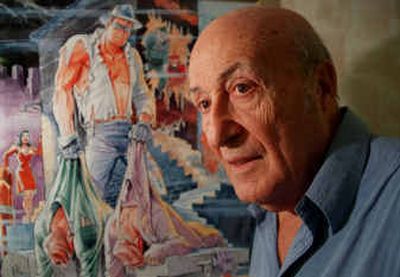Will Eisner, comic book pioneer, dies

Will Eisner, a titan of the comics world who in the 1940s brought to life characters such as The Spirit and Sheena, the Jungle Girl, and then three decades later shifted into far more realistic and gritty terrain by pioneering the graphic novel, has died. He was 87.
Eisner died Monday at Florida Medical Center in Lauderdale Lakes, Fla., after complications related to a quadruple heart bypass he underwent last month, according to Denis Kitchen, Eisner’s publisher for three decades and his agent in recent years.
The artist’s body of work, which began in earnest in the 1930s with the swashbuckling exploits of The Sea Hawk, will be capped by the May release of “Plot,” a graphic novel that is his personal take on the history of the Protocols of the Elders of Zion as a weapon against Jews. That book will be published by W.W. Norton & Co.
Eisner’s work was marked by sophistication; his Spirit newspaper strips are still hailed as a melding of German Expressionism’s imagery and the sly worldview of Hollywood’s screwball comedies. He was constantly innovating the use of panels, lettering and even format. The Spirit was published in newspapers from 1940 to 1952 in self-contained, four-color insert.
In similar fashion, Eisner would test the boundaries of comic books in 1978 with “Contract with God,” a collection of illustrated stories about real people that he called “a graphic novel,” marking a new area of ambition in comics.
Eisner devoted his recent decades to graphic novels about the struggles with poverty, aging and despair in titles such as “The Tenement” and “The Invisible People.” Since “Contract with God,” the pace had been roughly a book a year. “My stories are all centered around the human being, the business of survival, of struggling against the forces of life itself,” Eisner said in one interview. “We’re dealing with impossible and unbeatable forces, not a single monster. My interest is not the super hero but the little man, who struggles to survive in the city.” Author Michael Chabon, who fictionalized Eisner in his Pulitzer-Prize-winning novel, “The Amazing Adventures of Kavalier & Clay,” said Eisner was really the only one at the time to see comics for what they were: an artistic medium in which an artist could find new ways of telling stories.
“There’s no question, he (was) one of the most important figures in comic books,” Chabon said.
Since 1988, the comics industry’s top award has been called “The Eisner.” Eisner’s textbooks, “Comics and Sequential Art” and “Graphic Storytelling,” are required reading in the comics field and dovetail with his teachings at the New York School of Visual Art in New York City.
Art Spiegelman, who won the 1992 Pulitzer Prize for “Maus,” a graphic novel about the Holocaust, once called Eisner a “genius cartoonist who changed the vocabulary of comics.” Cartoonist Jules Feiffer declared him “a national treasure.”
This year, several museum exhibitions about Eisner have been set and two books concerning him are scheduled to be published: “Eisner/Miller,” a dialogue between Eisner and comics creator Frank Miller, and “Will Eisner: A Spirited Life,” a biography by author Bob Andelman.
Eisner was born March 6, 1917, in Brooklyn. His father, an émigré from Austria, painted stage sets and encouraged his son’s artistic aspirations. Eisner attended high school in the Bronx (along with his friend Bob Kane, who would go on to create Batman), and his first work was published in the school newspaper. In what later became industry legend, Eisner started a comics production company in 1937 with his friend Jerry Iger. Their $15 investment bought three months worth of rent on East 41st Street for their production company, Eisner & Iger.
“Like brokers who forecast a sudden demand for pork bellies, we believed that pulp publishers, who were repackaging newspaper comic strips into magazine-size formats, were going to run out of them at any minute,” Eisner recalled in the New York Times Book Review in 1990. That prediction would be a solid one.
The national demand for comics, spurred by the 1938 advent of Superman, exploded. Soon Eisner was writing and drawing under five names “in what would soon become a kind of artistic ghetto in which people with authentic, if offbeat, talents had to suffer the disdain of the mainstream,” he once wrote.
Eisner is survived by his wife, Ann, and son, John.